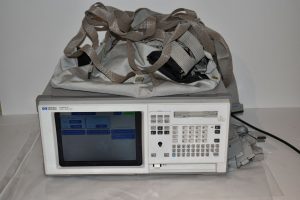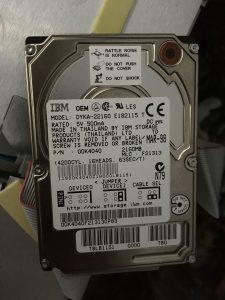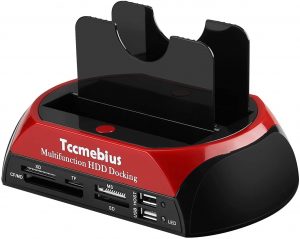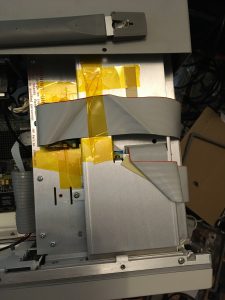Introduction
 The bench top Logic Analyzers from HP namely the HP 1660E/ES/EP-Series have a builtin IDE hard drive. While this hard drive is not used during the boot process of the Logic Analyzer, the hard drive can be necessarily to initialize some of the modules. Without the hard drive you may see errors like: not enough room to initialize modules. Since these drives are old, and can fail it might be smart to swap them out for a CF card.
The bench top Logic Analyzers from HP namely the HP 1660E/ES/EP-Series have a builtin IDE hard drive. While this hard drive is not used during the boot process of the Logic Analyzer, the hard drive can be necessarily to initialize some of the modules. Without the hard drive you may see errors like: not enough room to initialize modules. Since these drives are old, and can fail it might be smart to swap them out for a CF card.
The internal drive
 The internal drive is known as HP part number 0950-2801 or F1385-69100. Which turns out to be a IBM 2.5″ 2.1Gb laptop hard drive, model: DYKA-22160.
The internal drive is known as HP part number 0950-2801 or F1385-69100. Which turns out to be a IBM 2.5″ 2.1Gb laptop hard drive, model: DYKA-22160.
The plan is to replace this hard drive with a IDE CF Card adapter and a CF card of 2Gb.
Creating a Hard drive image
This should be the easy part. The process should go along the lines of:
-
- Opening the Logic Analyzer
- Take out the Hard drive
- Hook the hard drive up to a computer with a usb external hard drive docking system
- Create image from the hard drive
- Restore the created image to a CF card
Well it turns out to be not that easy. At least if your using Mac OS that is. In the past I tried several USB devices which should be able to present a external hard drive as a usable device under Mac OS. However most of those external USB hard drive docking thingies are not working properly. Or the USB device itself is not recognized by my Imac, or the device is recognized, but doesn’t show any device in Mac OS.
“Why don’t you use windows for that task?” I can almost hear you ask. Well, I don’t have any hardware lying around to run a physical Windows system on. Well I have a very old laptop which runs Windows XP, but has only very slow USB ports, which brings a lot of it own limitations to the table.
I use a windows 10 virtual machine, but for that to work the USB device much be recognized by Mac OS for this to work.
So step 1 is to find some usb device which is able to read laptop IDE’s and CF card at least. This USB device must work under Mac OS.
Let me introduce Tccmebius TCC-S862
 After a lot of searching I found the Tccmebius Harde Schijf Docking Station, TCC-S862-DE USB 2.0. Reading about this device it looks like it is supported by Mac OS. While not cheap, it’s not to expensive either. So for 28,00 euro found on Amazon it’s worth the gamble.
After a lot of searching I found the Tccmebius Harde Schijf Docking Station, TCC-S862-DE USB 2.0. Reading about this device it looks like it is supported by Mac OS. While not cheap, it’s not to expensive either. So for 28,00 euro found on Amazon it’s worth the gamble.
Quick review of the Tccmebius TCC-S862
There are a couple of different versions of the Tccmebius TCC-S862. The TCC-S862 can read XD / TF-card/ MS (Duo / Pro) -card / CF-card / SD-card). It also is able to read IDE disk (3.5″ and 2.5″) and SATA I,II,III as well. Even claims to support SSD disk. And this is a lot of functionality in one USB device.
Other models have for instance USB 3.0 support. However I read that it gives problems. Some had to use a USB hub to get it working. Since I wanted a device which could read CF, SD, and IDE and SATA I picked up this model.
Using the Tccmebius TCC-S862
While this device works under Mac OS without problems, not all is good. The quality of the usb device feels very cheap plastic. Inserting a CF card is scary. It’s easy to bend the pins (already done that). The CF card goes in upside down. And it’s difficult to place.
Placing a 2.5″ disk is also tricky. The manual states to remove any metal backplate. And I know understand why. The disk sits flat against the backsite of the slot. this makes it impossible to see where the pins and the connector mate. Risking again bending the pins.
Making the drive image with the Tccmebius TCC-S862
Once the hard drive and CF card are inserted without causing any damage, the disks shows up as devices under Mac OS.
To get a list of hard drive devices use:
sudo diskutils list
That’s the good news. So the next step is to use the ‘dd’ command to create a image from the hard drive.
This is done by using for example the command:
sudo dd if=/dev/rdisk3 of=hp1660es_disk.img bs=4096
The bs parameter (Block Size) is determined by selecting a size which gives the best performance. However I discovered that by setting the bs to a high value, the error:
disk /dev/disk3 is unconfigured
popsup. I’ve tested this under Windows 10 in a VM, and also get errors with the device as I choose the number to high.
And yes, you can use the dd command under windows as well. I’ve installed git under windows, and that comes with some Unix tools, like the command ‘dd’.
So after leaving the bs parameter alone, I could create a disk image. Which is great. Placing the created hard drive image back unto the 2Gb CF card was easy to do with the dd command as well. I used a command like:
sudo dd if=hp1660es_disk.img of=/dev/rdisk3
( I removed the IDE HD at this point, and the CF card reported itself as disk3.)
So while the Tccmebius TCC-S862 is not very user friendly, it kinda works. Maybe there a better solutions out there, I don’t know. But having a device which actually works under Mac OS is a big plus. However think twice if you really want to buy this device.
Installing the CF card into the HP 1660 Logic Analyzer
 After the CF card was prepared by placing the disk image on it, installing the CF card adapter and CF card into the Logic Analyzer was easy. For now I used kapton tape to make sure the CF adapter cannot short out, and also for now taped the adapter to the chassis. This doesn’t look nice, but as this is a temporarily fix, till I know for sure it works reliable. And we all know how permanent a temporarily fix is.. right ?
After the CF card was prepared by placing the disk image on it, installing the CF card adapter and CF card into the Logic Analyzer was easy. For now I used kapton tape to make sure the CF adapter cannot short out, and also for now taped the adapter to the chassis. This doesn’t look nice, but as this is a temporarily fix, till I know for sure it works reliable. And we all know how permanent a temporarily fix is.. right ?
Hello,
I have that same machine, but the hard drive is broken. Is it possible to get the image you created, so that I can create new hard drive with it?
BR,
Otto
Hello Otto,
Yes, I can do that. However I don’t how to get a 2.1Gb size image to you. have you some place where I can upload the image?
Hello hades,
Maybe best would be to use something like google drive, droppox or sendbig.com. If it is too much of hassle, send me an email and we’ll figure something out.
I’m not very good with google drive, but hopefully the following link works: https://drive.google.com/drive/folders/1r1JLYM4DYnAQm1Z7i71tv3JhZ-Iy8QL2?usp=sharing
Hopefully you can get your HP660ES LA up and running!
Thanks a lot! The machine worked already, but the hard drive was broken. Now that works also.
Hello Otto,
Great to hear that your drive is now working! Yes you’re correct, these type of logic analyzers work without hard drive. That is that they boot. The software for the LA is stored in ROM. However, my LA won’t work fully. Without a hard drive, the LA complains about not enough room to initialize all the cards. Anyway glad I could help 🙂
Do you have the disks for the ROM software?
I thought I could update the ROM from the hard disk but this didn’t work (it looks like I need to do it off floppies). I now have a non operating 1660ES!
I can’t find the software on the internet.
Hello Michael,
Sorry for the late reaction, I don’t always have the time to give a quick response. In this case: Long response incoming:
First of all sorry to hear that your HP 1660ES is bricked 🙁 I don’t have the floppies nor do I have any ROM image(s). The disk image you requested access to doesn’t help you either. The 1660ES boots from it’s internal ROM (flash) and doesn’t need a working internal hard drive. The internal hard drive is used to store files (configuration, traces, etc). The internal hard drive maybe needed when extra cards (options) are installed.
At this moment the best option could be to ask for help in the EEVBlog forum. If you don’t have an account, create one and ask for help there. There are a lot of members which play around with LA’s like the 1660 series, so just maybe someone got the floppy disk images and or ROM/Flash images.
I really hope you can get your LA fixed, and sorry that I can’t help you any further.
Yes, I did post on EEVblog and on the Keysight forum (& HP groups) but without success.
Before I lost access to the hard drive I dis find the files system and system.lan (I was looking for the .lan file because my Ethernet connection was not working).
This was why I thought your hard drive may them also. It seems like the 1660E/ES is less common than the older C/CS.
I might try using the CS files … it’s risky but I’m not sure I have much to loose. It may give me access to the hard drive at lease (where I might be able to get the files).
thanks,
Michael
Hello Michael,
I Give you read access to the hard disk file. Hopefully you can find the files, and get your LA up and running again. I’m not sure.. but from what I remember the floppy disk are using FAT. Maybe it’s possible to boot with a DOS floppy ?
The image cannot be mounted on PC or Linux.
I think it’s a modified dos format done by vxworks.
There is a Linux driver that might work (https://github.com/jens-maus/vxext_fs) but it was done for an older version of the kernel than I have so I would have to spin up an older Linux environment to test it. (not a trivial matter but I might have to do it)
Since you are able to view the disk on the 1660e, can you be so kind as to look to see if the ROM, SYSTEM and SYS_032 files are there? I don’t remember which directory I saw the system and system.lan files but my 1660es finds (when it tries to flash from hard disk) the ROM file in \SYSTEM\ (it doesn’t find the other two files but it may also be looking for them in \SYSTEM\)
thanks,
Michael
I didn’t understand what your asking for, because the hard drive image doesn’t contain any files which are required for booting the LA. So I looked up your posting on the EEVBlog forum, and saw the screen capture of the boot process, and where you’re LA got stuck. And now I’m understanding what your asking for. The SYSTEM dir (I expect) is mounted on the HD during the boot process of the LA. So I fired up my LA and yes.. I can see those files. So I have them. The plan is: First to format a floppy disk (in DOS format). Copy over the files to the floppy disk (and I’m also going to try to copy over the whole system dir, hopefully it fits).
Image the floppy disk, and share it with you. So this will take some time, hopefully in a couple of hours I got a disk image. If that doesn’t work, I’ll just ftp over the whole system dir, zip it, or tar it, and share it with you.
Hello Michael,
If you look on google drive dir, you’ll see a new image file. This is as described in my previous reply a floppy disk image. It contains the files:
ls B16500/SYSTEM/BADTIME.TIF LG165.BDF PVTEST_ ROM SM165.BDF SYSTEM.LAN SYSTEM.MAP
Hopefully with these files you can fix your LA. I don’t know if the versions are correct. Let me know if this fixed your LA, or that you need other files. Like I said in the previous reply, I.m going to try to create a file with all the files of the SYSTEM dir (and subdirs). And share that on google drive.
Fantastic! I see the files. Hopefully these will work.
My guess is that my disk also has these but it’s looking for ‘system’ not system.lan’.
I’ll rename system.lan to system and put the files on a floppy.
When doing the ROM reprogramming, the LA looks at the floppy and then asks if it should try the hard drive. (it fails when it can’t find ‘system’).
Believe it or not, I don’t have any computers here that have a floppy 😎 I’ve got one coming in the mail so I can try the fix. I’ll let you know.
The odd thing about this unit was that the LAN did not show on the setup menus.
All E models were supposed to have the LAN option. When I opened up the unit to image the drive I saw that the ribbon cable that goes to the LAN board was unplugged. I didn’t disassemble the device enough to see where it went (or if it went to a motherboard card that was not there). I’ll tackle that problem when I get the ROM reprogrammed.
Thanks again, this may have saved me!
I fixed it!
After writing the last reply, it dawned on me that the reason it was asking for ‘system’ and not ‘system.lan’ was because it couldn’t see the Ethernet hardware (because it was unplugged). I had read this post on the 1660CS (https://www.jamiecraig.com/hp1661cs-ethernet-interface/) but it didn’t click until now.
I opened up the unit and found where the cable should be plugged in.
After reassembling, it asked for rom, system.lan and sys_032 … all of which it found on the hard drive!
I guess the software for the E was a small modification of the C version and it had the code still in place to distinguish between a unit with and without Ethernet. (even though by version E the Ethernet was always present)
Thanks for all your help and time … I really appreciate it.
Nice to hear that you fixed it 🙂 And now at least the firmware files are available, in case someone needs them. Glad to be of help.